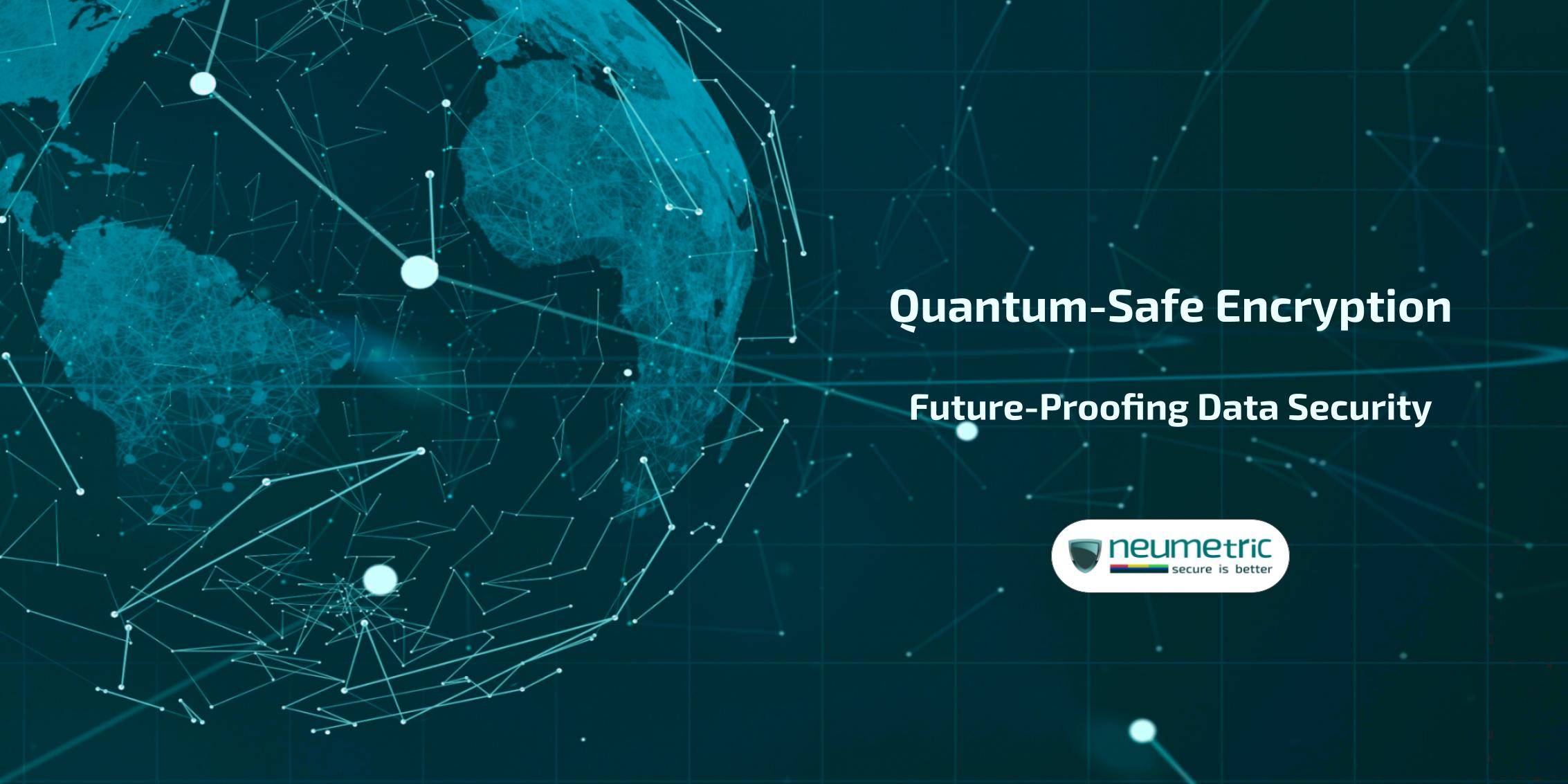Table of Contents
ToggleIntroduction
In the rapidly advancing landscape of technology, quantum computers leverage quantum bits or qubits, harnessing the principles of quantum mechanics like superposition & entanglement to perform complex calculations at an exponential speed. As quantum computing emerges on the horizon of possibility, it brings forth both remarkable opportunities & significant challenges. One of the most pressing challenges lies in the realm of data security, specifically in the field of encryption.
Encryption, the cornerstone of cybersecurity, is the process of encoding information to protect it from unauthorised access. Current encryption methods, based on mathematical problems that classical computers find difficult to solve, form the backbone of secure communication, financial transactions & sensitive data storage across the digital sphere.
However, the imminent arrival of scalable quantum computers threatens the robustness of these encryption methods. As quantum computing matures, the sophisticated algorithms that currently safeguard sensitive information could become susceptible to decryption, potentially exposing vast amounts of data to unauthorised access & exploitation.
Understanding Quantum-Safe Encryption
As the advent of quantum computing approaches, the urgency to fortify data security against its potential threats intensifies. Quantum-safe encryption, often termed post-quantum cryptography, serves as the cornerstone of this defence, aiming to create cryptographic systems impervious to quantum algorithms’ computational prowess.
The Need for Quantum-Safe Encryption
Traditional encryption methods rely on mathematical problems that are hard to solve for classical computers, forming the basis of secure communication & data protection. However, these algorithms, such as RSA & ECC, face vulnerability when confronted with the computational power of quantum computers.
Quantum-safe encryption becomes imperative to thwart the threat posed by quantum algorithms, ensuring data confidentiality & integrity in the impending era of quantum supremacy.
Principles of Quantum-safe Encryption
- Post-quantum Cryptography: This branch of encryption focuses on algorithms that resist attacks from both classical & quantum computers. It involves mathematical approaches that withstand quantum algorithmic attacks.
- Mathematical Approaches: Various mathematical problems form the foundation of quantum-resistant encryption, such as lattice-based, code-based, multivariate & hash-based cryptography. These cryptographic schemes leverage mathematical constructs that remain resilient even in the face of quantum attacks.
- Key Exchange Mechanisms: Quantum-safe encryption also encompasses secure methods for exchanging cryptographic keys in a quantum-resilient manner, ensuring that keys remain confidential & secure even against quantum adversaries.
Developing encryption protocols that can withstand the computational might of quantum computers is not only a technical challenge but a critical necessity to ensure the continued trustworthiness & security of digital communication, financial transactions & sensitive data storage.
Risks of Inadequate Encryption in the Quantum Era
The advent of quantum computing brings forth a new era of computational power, simultaneously posing unprecedented risks to traditional encryption methods. Understanding the potential consequences of inadequate encryption in the quantum era is crucial in comprehending the urgency to transition to quantum-safe encryption.
Vulnerabilities of Current Encryption Methods
- Exponential Speed of Quantum Algorithms: Quantum computers have the potential to exponentially accelerate computations for certain mathematical problems. Algorithms like Shor’s algorithm can factorise large numbers exponentially faster than classical algorithms, threatening the security of widely-used encryption schemes like RSA & ECC.
- Data Exposure & Privacy Concerns: Inadequate encryption in the quantum era could lead to the exposure of sensitive information, including personal data, financial records & classified communications. This could result in severe privacy breaches & exploitation by malicious entities.
Potential Consequences of Data Breaches in the Quantum Age
- Financial Impacts: Breaches in encryption could have far-reaching financial repercussions. Instances of compromised financial transactions, manipulated digital signatures or unauthorised access to financial databases could cause significant economic losses.
- Privacy Concerns: The compromise of encrypted data due to quantum attacks could undermine individual privacy on an unprecedented scale. Personal information, health records & confidential communications might fall into the wrong hands, eroding trust in digital systems.
- National Security Risks: Governments & critical infrastructure heavily rely on secure communications. Breaches in encryption could jeopardise national security by enabling adversaries to intercept & decrypt classified communications, leading to potential intelligence breaches & cyber-espionage.
The looming threat of quantum-powered decryption emphasises the urgency for organisations, governments & individuals to transition to quantum-safe encryption. Proactive measures & investments in quantum-resistant cryptographic algorithms & protocols are essential to mitigate the risks associated with inadequate encryption in the quantum computing era.
Exploring Quantum-Safe Encryption Solutions
In response to the looming threat posed by quantum computing to traditional encryption, researchers & cryptographers are actively developing quantum-safe encryption solutions. These solutions aim to fortify data security against the potential decryption capabilities of quantum algorithms.
Types of Quantum-Resistant Algorithms
- Lattice-Based Cryptography: Leveraging the hardness of certain lattice problems, this approach offers promising quantum-resistant encryption schemes. Lattice-based cryptography provides a mathematical foundation for creating secure cryptographic primitives, such as digital signatures & key exchange protocols.
- Code-Based Cryptography: Built upon error-correcting codes, this form of encryption relies on the complexity of decoding certain types of codes. Code-based cryptography has a long-standing history & is known for its resilience against quantum attacks.
- Multivariate Cryptography: Operating on the complexity of solving systems of multivariate polynomial equations, this cryptographic approach offers potential quantum-resistant algorithms. However, its practical implementation & efficiency pose ongoing challenges.
- Hash-Based Cryptography: Drawing strength from the difficulty of inverting hash functions, this method constructs digital signatures & other cryptographic primitives resistant to quantum attacks. Hash-based schemes, like the Merkle signature scheme, have gained attention for their quantum resilience.
Implementing Quantum-Safe Encryption Protocols
- Challenges & Limitations: The transition to quantum-safe encryption faces several challenges. Adoption requires careful consideration of backward compatibility with existing systems, computational efficiency & standardisation of new cryptographic protocols.
- Progress & Adoption Rates: While significant strides have been made in the development of quantum-resistant algorithms, the adoption & integration of these protocols into existing systems & cryptographic standards remain ongoing processes. Industries & governmental bodies are gradually embracing these solutions to prepare for the quantum era.
Addressing the challenges associated with quantum-safe encryption implementation involves collaboration among researchers, industry stakeholders & standardisation bodies.
Moreover, ensuring the efficiency, security & interoperability of these cryptographic solutions remains paramount for their widespread adoption. The evolution of quantum-safe encryption marks a pivotal phase in ensuring data security resilience in the face of impending quantum computing capabilities.
Transitioning to Quantum-Safe Encryption
The paradigm shift towards quantum-safe encryption necessitates a strategic & proactive approach to safeguarding data integrity in the impending quantum computing era. Industry, governmental initiatives & strategic planning play pivotal roles in facilitating a seamless transition to quantum-resistant encryption methods.
Industry & Government Initiatives
- Research & Development Funding: Governments & private entities are allocating substantial resources towards research & development in quantum-safe encryption. Funding initiatives support the exploration & creation of robust cryptographic algorithms resilient to quantum attacks.
- Collaborative Efforts: Collaborations among academia, industry & government agencies drive innovation & standardisation efforts. Forums, consortia & international collaborations foster the development of standardised quantum-safe encryption protocols.
Strategies for Transitioning to Quantum-Safe Encryption
- Timeline & Planning: Establishing a clear timeline for transitioning to quantum-safe encryption is crucial. Organisations need strategic plans that outline phases of adoption, testing & implementation to ensure a smooth transition without compromising data security.
- Integration into Existing Systems: Retrofitting existing systems with quantum-safe encryption measures requires meticulous planning. Compatibility assessments & gradual integration strategies are essential to minimise disruptions to operations.
- Addressing Compatibility Issues: Ensuring interoperability between legacy systems & emerging quantum-safe encryption standards is paramount. Strategies involving hybrid encryption, where both classical & quantum-safe algorithms coexist, aid in this transition phase.
The transition to quantum-safe encryption is not merely a technological shift but a comprehensive endeavour involving technical, operational & strategic considerations. Organisations & governmental bodies need to allocate resources, update policies & educate stakeholders to navigate this transition effectively.
The Future Landscape of Data Security
The emergence of quantum-safe encryption marks a transformative era in data security, reshaping the strategies & technologies safeguarding sensitive information. Understanding the evolving landscape & implications of quantum-safe encryption provides insights into the future of data protection.
Impact of Quantum-Safe Encryption on Cybersecurity
- Enhanced Resilience: Quantum-safe encryption introduces robust cryptographic techniques that withstand both classical & quantum attacks. This heightened resilience fortifies data against evolving threats, ensuring long-term security.
- Innovation in Security Measures: The pursuit of quantum-safe encryption fosters continuous innovation in cryptographic protocols. This ongoing evolution spurs the development of more secure & efficient encryption methods across various industries.
Evolution of Encryption Standards & Protocols
- Standardisation Efforts: Standardisation bodies are actively working to establish global standards for quantum-safe encryption. Efforts aim to ensure interoperability, reliability & uniformity in implementing secure encryption protocols.
- Adoption & Integration: As quantum-safe encryption matures, industries are progressively adopting these protocols. Integration into existing infrastructures & protocols is essential, driving the need for seamless migration strategies.
Foreseeing the Next Generation of Quantum-Resistant Technologies
- Continued Research & Development: The quest for superior quantum-resistant algorithms persists. Ongoing research focuses on refining existing algorithms & exploring novel approaches to fortify data security.
- Technological Advances: Advancements in quantum computing & cryptographic techniques pave the way for more sophisticated security measures. Innovations in quantum key distribution & quantum-resistant cryptography shape the future of secure communications.
The future landscape of data security revolves around the convergence of quantum-safe encryption with traditional security measures. As quantum computing matures, the widespread adoption of quantum-resistant algorithms will be imperative to maintain data confidentiality & integrity.
Conclusion
The rapid evolution of technology, particularly the advent of quantum computing, presents both remarkable opportunities & profound challenges, particularly in the realm of data security. As we stand at the precipice of this transformative era, the importance of transitioning to quantum-safe encryption cannot be overstated.
The journey towards quantum-safe encryption is not merely a response to an imminent threat; it embodies a proactive stance, ensuring the resilience of data security against the formidable computational power of quantum computers.
FAQ
Why worry about quantum computing & encryption?
Quantum computing threatens current encryption by rapidly solving complex maths, jeopardising data security.
What’s quantum-safe encryption & why does it matter?
It’s encryption resistant to quantum attacks. It’s crucial to secure data against future quantum threats.
What happens if encryption isn’t upgraded for quantum?
Organisations could face financial losses, privacy breaches & national security risks.
What kinds of quantum-resistant encryption exist?
Approaches include lattice-based, code-based, multivariate & hash-based cryptography.
How can organisations switch to quantum-safe encryption?
Planning, compatibility checks & gradual integration are key, along with industry & government collaboration.





